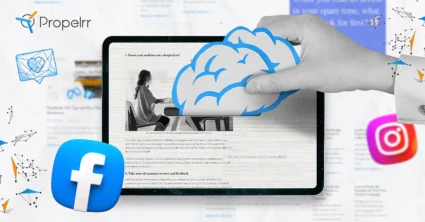5 Ways to Inject Emotional Resonance in Your Online Content
Author & Editor
Content Team Lead
Published on: Jun 16, 2021 Updated on: May 16, 2024

Every year, local food giant Jollibee makes waves on social media for its tear-jerking campaigns. Be it for a Valentine's or Father's Day campaign, their short clips exude emotional resonance through relatable stories such as an unrequited love, a family paying tribute to their deceased member, or a relationship strengthened by life’s different challenges.
And while Jollibee's signature products are understandably visible in these clips, they take the back seat. The spotlight is always on the story that resonates with millions of Jollibee patrons everywhere.
Marketing campaigns that target key emotions is not a new concept. In the 1960s, tobacco brand Marlboro created the persona of a cowboy in the fictional Marlboro Country. The ads were undeniably masculine in all of their rugged glory – a burly man riding with horses in the middle of the wilderness. Marlboro’s macho appeal was such a success that Marlboro Country was well-known until the ‘90s.
In the TV series Mad Men, Don Draper (played by actor Jon Hamm) pitched his idea for Kodak Carousel where he likened the slide projector to a time machine that brings back the past and all the emotions associated with it. Before the Kodak bosses, Draper said:
“This device isn’t a spaceship. It’s a time machine. It goes backwards, forwards. Takes us to a place where we ache to go again. It’s not called ‘The Wheel.’ It’s called ‘The Carousel.’ It lets us travel the way a child travels. Around and around and back home again to a place where we know we are loved.”
Brands explore ways on how to attract and hold the attention of their customers using emotional resonance. Stanford Medicine defines emotional resonance or emotional advertising as “I feel your pain“, and may be of two types:
- identical resonance: realizing that another person is in pain and actually feeling the pain yourself; or
- reactive resonance: sympathizing with someone else's pain and feeling inclined to help.
The emotion may be poignant such as in Draper’s pitch for Kodak Carousel; pain and hope like in the Jollibee Valentine's videos; or excitement similar to that in old Marlboro ads. It may also involve a combination of various sentiments, taking the audience for an emotional roller coaster ride.
As a veteran content marketing agency like Propelrr understands how emotional resonance can evoke a feeling of being in the right place. This is powerful in grabbing people's attention and getting your message across to inspire action.
Why is emotional resonance important in marketing?
Audiences don't like interacting with brands that only talk about their products. Not in this age where authenticity and empathy is demanded of businesses. This emotional connection with your audience doesn't just drive customer conversions, but also increases your retention and, in the best of cases, turn your audiences into advocates for your product or service.
To be specific, the whole idea of marketing authentically and with empathy is mainly driven by these factors:
- It makes your brand relatable.
There are countless brands vying for the attention of your target audience. Stand out by reaching out to people on a personal level. Through emotionally resonant content, you can convey to your audience that you understand their pain points and innermost desires and that you have the very solutions they’ve been looking for.A relatable brand helps develop a sense of security and trust. Your audience will realize that with you, they are well taken care of. - It shifts the spotlight from you to your audience.Nobody wants pushy marketing which is more concerned with making an immediate sale than nurturing relationships that build brand loyalty. This type of one-sided marketing only talks about the products and services, focusing on what you have to offer, instead of what your audience truly wants or needs.Emotionally resonant content puts the spotlight on your audience. It highlights their desires and pain points and all its associated emotions. It also keeps you from being pushy and annoying.
- It can help inspire action.
Content that triggers the right emotions tend to be more impactful than content that arouses rational response. Dutch brewery Heineken used emotional resonance in its Worlds Apart campaign which promotes openness and explores how common ground can bind and unite people.Heineken is a global brand and its strength is in the diversity of its customer base. Through its World Apart campaign, it tells everyone that it is a brand that values openness and unity and inspires others to manifest these in their everyday lives.Molly Biwers – a member of Hallmark Cards, Inc.’s Marketing leadership team – told Forbes:It's not about pushing your brand message but more about being invited in by consumers. Talk about something that's relevant and important to them. You need to take risks to build your brand.
How do you build emotional resonance?
An emotionally resonant content entails a lot of research on the audience, the topic, which emotions to set off, and the right medium to use. There is no one method of doing this, but the guide below can help you customize your marketing campaign, as you see fit:
- Know your audience on a deeper level
- Take note of customer reviews and feedback
- Take big risks
- Deliver your message in the most effective way
- Stay clear with your purpose
1. Know your audience on a deeper level

Photo courtesy of Christina @ wocintechchat.com on Unsplash
The marketing team behind Jollibee's Valentine campaign knows the brand's target audience very well: Filipinos who value meaningful relationships above anything else. Hence, the subject of its Valentine clips are people surviving against all odds with their family, friends and significant others as their source of strength.
To create similarly effective content, you need to identify and understand your audience on a profound level. Go beyond their demographics and dig deeper into desires, pain points, values, and other emotional drivers.
2. Take note of customer reviews and feedback
Understand what makes people happy about your brand and what frustrates them. Do they appreciate your tutorial videos? Do they want an easier way of getting in touch with you? What do they truly care about? Read the reviews on your website and social media accounts, and use these to learn your customers’ positive and negative experiences about your brand.
To gain access to this type of data, you can send out email surveys where you may explore two ways of deeply understanding your audience. These two ways specifically are with direct reporting, or metaphor elicitation. Both are discussed below.
- Direct reporting. Through direct reporting, you analyze self-reported (reported by the subject) emotions through word map matrices. You will then attribute each reported emotion to an overall theme such as love, joy, anger or fear. If a survey respondent mentions feeling “glad”, you may attribute this to the “joy” theme.
- Metaphor elicitation. With metaphor elicitation, you use simile or metaphoric prompts such as images or stories that relate to certain emotions. The respondent chooses the emotional response to a prompt instead of using descriptive words.
- Create limbic personas - Buyer personas provide you information about your target audience based on their habits and personality traits. This will be more useful if you also have information about the values and emotions that resonate with your audience.
A German research group, Gruppe Nymphenburg, developed a map that shows all human motives, desires and values, and how these relate to one another. The limbic map® provides a framework that can help you identify the emotions and values that resonate most strongly with your target audience. This can guide you in creating emotionally focused buyer personas or limbic personas.
To incorporate the limbic map into your personas – first, cluster your audience into the following main categories:
- Stimulant: being creative, spontaneous, and exemplifying values of openness
- Dominance: wanting to be better than others, aspiring for power and position, and being unique
- Balance: being traditional and risk-averse, aspiring for safety and security
Then, be more specific about your audience's limbic profiles by further classifying them into any of the following limbic resonance types:
- Hedonist: curious, spontaneous, fun, creative, individually, extroverted, loves diversification
- Open-minded: feeling good, open-minded, fanciful and dreaming, flexible, broad-minded, loves enjoying with all his senses
- Harmonizer: family-oriented, harmony-oriented, caring, cordial, needs feeling of security
- Traditionalist: traditional, modest, decent, structured, wants to safeguard himself against everything
- Disciplined: frugal, reasonable, disciplined, precise, dutiful, logical, prefers clear structure
- Performer: performance-oriented, focused on success, ambitious, status-oriented, wants to establish himself
- Adventurer: impulsive, adventurous, autonomous, rebellious, likes challenges
To encourage people to take part in your surveys, consider offering freebies or a chance to win prizes. Remember that your respondents will be “donating” their time and effort to help with your research.
3. Take big risks
Before 2020 ended, Philippine soft drink brand RC Cola broke the internet with its Kafkaesque ad. The ad content earned more than 1.6 million organic views within six hours of launch. The story was about a young boy who confronts his mother about being adopted. She then proves her maternal authenticity in such a bizarre way. Check the video below to see for yourself. The content was “too weird” for some, but was a big hit among its target audience: Gen Z.
RC Cola and its marketing agency took a big risk in using “oddvertising”, stirring feelings of surprise, confusion, and even disgust. Go big or go home, so to speak. But it is important to assess the risk of using emotional resonance with your content. There is a chance, no matter how miniscule, that you might offend people or just will not trigger the right emotions and inspire action.
But you will never know until you try. And should you make a mistake, learn from it. As Huffington Post Founder Arianna Huffington puts it:
We need to accept that we won't always make the right decisions, that we'll screw up royally sometimes – understanding that failure is not the opposite of success, it's part of success.
4. Deliver your message in the most effective way

Photo courtesy of Headway on Unsplash
After knowing the pain points of your audience, know how to tell them that you relate with them – that you understand their anxieties and fears – in the most effective way.
Remember that the key to emotional resonance is delivering your message without being direct, without using descriptive words. Think of the opening sequence to the Pixar film “Up”. The montage communicated the highs and lows of married life to the audience without using a single word, but just through moving images in a continuous sequence.
Video is possibly the best medium for emotionally resonant content. This will allow your audience to see the facial expressions and body cues of the actors, essential in conveying emotions. You may also use powerful photos. The World Wildlife Fund (WWF) uses fear-inducing images to increase awareness on climate change.
5. Stay clear with your purpose
Marketing campaigns are created for a unique and specific purpose. For instance, Jollibee taps into Filipinos' sensibilities to boost brand loyalty. RC Cola creates “weird” ads to resonate with the young and experimenting Gen Z. The WWF uses scare tactics to inspire people to take action against climate change.
Be clear with your purpose, and use this as your guide to create and distribute your content. Do you want your audience to appreciate your brand on a deeper level or connect with your brand in a more personal way? Do you want them to act as ambassadors?
If you want your customers to share the best experiences they’ve had with your brand, your goal is to “recruit” them as brand ambassadors. Keep this purpose in mind when choosing which emotions to trigger in your content. For instance, if your customers are passionate about the zero-waste movement, focus on the values and emotions related to environmental conservation, personal accountability and immediate action.
Key takeaways
Emotional resonance is all about telling your audience that you understand their desires and pain points and that your brand has the solutions they are looking for. By incorporating emotions into your content, you are able to connect with people on a deeper level beyond sales and transactions. This is an important element in boosting brand loyalty and nurturing long-term relationships.
To effectively use emotional resonance, remember to:
- Conduct extensive research about your target audience. Aside from understanding their buying habits and personality traits, know about their values and emotional responses to certain situations
- Consider taking big risks, but assess the risks well to foresee if it could be a win or lose in your business objective.
- Stay clear with your purpose. Creativity is the fuel to emotionally resonant content. But always remember the objective of your content as it will help you inspire the right action from your audience.
Do you have other thoughts about emotional marketing? Share them with us. Follow Propelrr on Facebook, X or LinkedIn.
